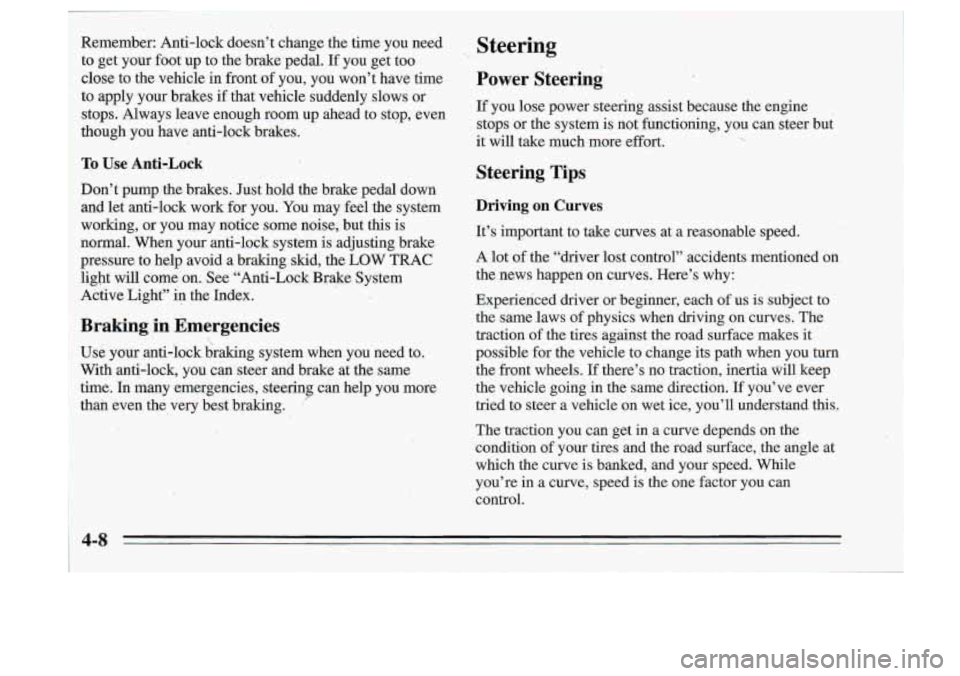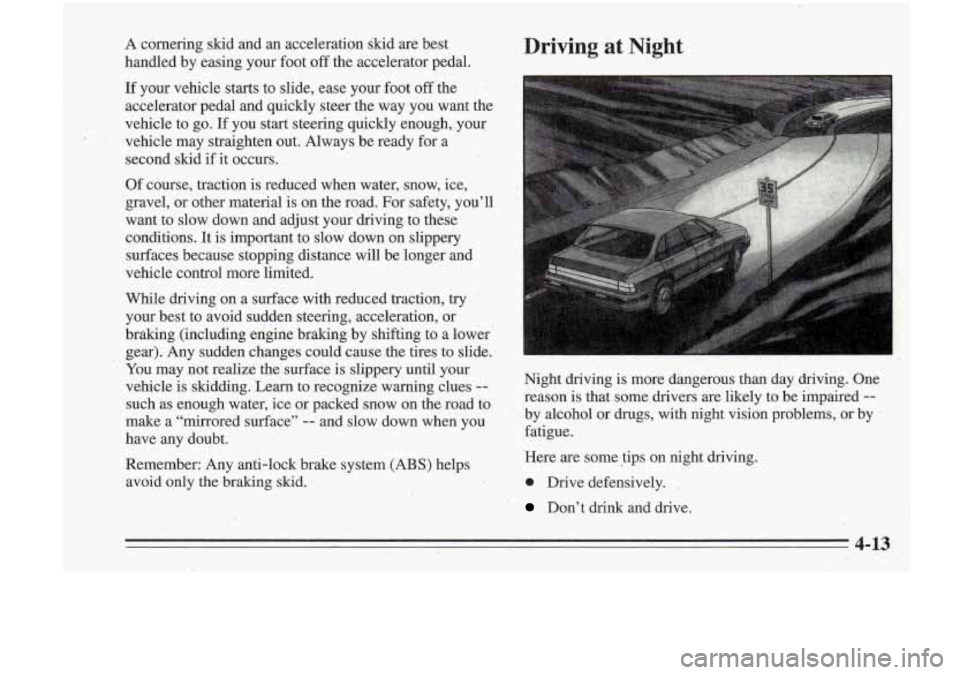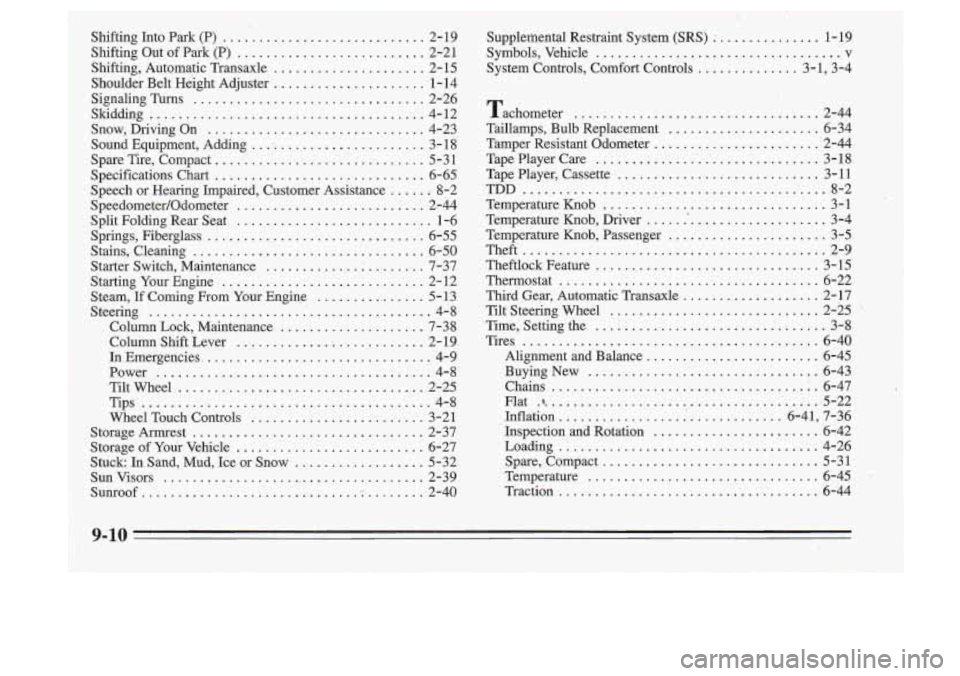1995 Oldsmobile Cutlass Supreme traction control
[x] Cancel search: traction controlPage 146 of 340

Remember: Anti-iock doesn’t change the time you need
to get your foot up to the brake pedal.
If you get too
close to the .vehicle in front of you, you won’t have time
to apply your brakes
if that vehicle suddenly. slows or
stops. Always leave enough room up ahead to stop, even
though
you have anti-lock brakes.
,_ Steering
Power Steering
If you lose power steering assist because the engine
stops
or the system is not, functioning, you can steer but
it will take much more effort.
. ..
To Use Anti-Lock
Don’t pump the brakes. Just hold the brake pedal down
and let anti-lock work for you. You may feel the system
working, or you may notice some noise, but this is
normal. When your anti-lock system is adjusting brake
pressure to help avoid a braking skid, the LOW TRAC
light will come’on., See “Anti-Lock Brake System
Active Light”
in the Index.
Braking .,in Emergencies
Usti your anti-lock braking system when you’need to.
With anti-lock, you can steer and brake at the same
time.
In many emergencies, steering can help you more
than even the very best braking.
.‘
Steering Tips
Driving on Curves
It’s important to take curves at a reasonable speed.
A lot of the “driver lost control” accidents mentioned on
the news happen on curves. Here’s why:
Experienced driver or beginner, each
of us is subject to
the samelaws of physics when driving on curves. The
traction of the tires against the road surface makes it
possible for the vehicle to change its path when you
turn
the front wheels. If there’s no traction, inertia will keep
the vehicle going in the same direction. If you’ve ever
tried to steer a vehicle on wet ice, you’ll understand this.
The traction you can get in a curve depends on the
condition of your tires and the road surface, $the angle at
which the curve is banked, and your speed. While
you’re in a curve, speed is the one factor you can
control.
Page 151 of 340

A cornering skid and an acceleration skid are best
handled by easing your foot
off the acce1,erator pedal.
If your. vehicle starts to slide, ease your foot off the ’’
accelerator pedal and’ quickly steer the way you want the
vehicle to go. If you start steering quickly enough,.your
vehicle may straighten out. Always be ready for a
second skid if
it occurs.
Of course, traction is reduced vvhen water, snow, ice,
gravel,
or other material is on the road. For safety, you’ll
want to slow down and adjust your driving to these
conditions. It is important to slow down on slippery
surfaces because stopping distance will ,be longer and
vehicle‘ control more limited.
While driving-on
a surface with reduced traction, try .
your best to avoid sudden steering, acceleration, or
braking (including engine braking by shifting to a lower
gear). Any sudden changes could cause the tires to slide.
You may
pot realize the surface is slippery until your
vehicle is skidding. Learn to recognize warning clues
--
such as enough water, ice or packed snow on the road to
make a “mirrored surface” -- and slow down when you
have any doubt.
Remember: Any anti-lock brake system
(ABS) helps
avoid,only the braking skid.
Driving at Night
I ~
Night driving is rnore’dangerous than day driying. One
reason is that some drivers are likely to be impaired-
--
by alcohol or drugs, with night vision problems, or by .
fatigue.
Here are some tips on night driving.
0 Drive defensively. -
’ Don’t drink and drive.
4-13 ,.
Page 336 of 340

Shifting Into Park (P) ............................ 2- 19
Shifting Out of
Park (P) .......................... 2-21
Shifting. Automatic Transaxle
..................... 2- 15
Shoulder Belt Height Adjuster
..................... 1-14
Signaling Turns
................................ 2-26
Skidding
...................................... 4-12
Snow. Driving On
.............................. 4-23
Sound Equipment. Adding
......................... 3- 18
Spare Tire. Compact ............................. 5-31
Specifications Chart
............................. 6-65
1 Speedometer/Odometer .......................... 2-44
Split Folding Rear Seat
........................... 1-6
Springs. Fiberglass
.............................. 6-55
Stains. Cleaning
................................ 6-50
Starter Switch. Maintenance
...................... 7-37
Starting Your Engine
............................ 2- 12
Steering ....................................... 4-8
Column Lock. Maintenance 7-38
Column Shift Lever
: 2- 19
.Power
...................................... 4-8
- . .‘.Tilt Wheel .................................. 2-25
.. Wheel Touch Controls ........................ 3-21
Storage Armrest
................................ 2-37
Storage of Your Vehicle
.......................... 6-27
Stuck: In Sand. Mud. Ice or Snow
.................. 5-32
Speech or Hearing Impaired. Customer Assistance
...... 8-2
Steam.
If Coming From Your Engine ............... 5- 13
....................
............. ............
.. In Emergencies ............................... 4-9
.Tips
........................................ 4-8
....
Supplemental Restraint System (SRS) : .............. 1-19
Symbols. Vehicle
.................................. v
System Controls. Comfort Controls .............. 3.1. 3.4
Tachometer
.................................. 2-44
Taillamps. Bulb Replacement
..................... 6-34
Tamper Resistant Odometer
....................... 2-44
Tape Player Care
............................... 3-18
Tape Player. Cassette
............................ 3-11
Temperature Knob
............................... 3-1
Temperature Knob, Driver
.......................... 3-4
Temperature Knob. Passenger
...................... 3-5
Theft
.......................................... 2-9
Theftlock Feature
............................... 3-15
Thermostat
.................................... 6-22
Third Gear. Automatic Transaxle
................... 2-17
Tilt Steering Wheel
............................. 2-25
Time. Setting the
... ; ............................ 3-8
Tires
......................................... 6-40
Alignment and Balance
........................ 6-45
BuyingNew
................................ 6-43
Chains
..................................... 6-47
Flat
. 4. ...................................... 5-22
Inflation
............................... 6-41, 7-36
TDD
........................................... 8-2
Inspection and Rotation
....................... 6-42
Loading
.................................... 4-26
Spare, Compact
.............................. 5-31
Sun Visors
.................................... 2-39 Temperature ................................ 6-45
Sunroof
........................................ 2-40 Traction .................................... 6-44